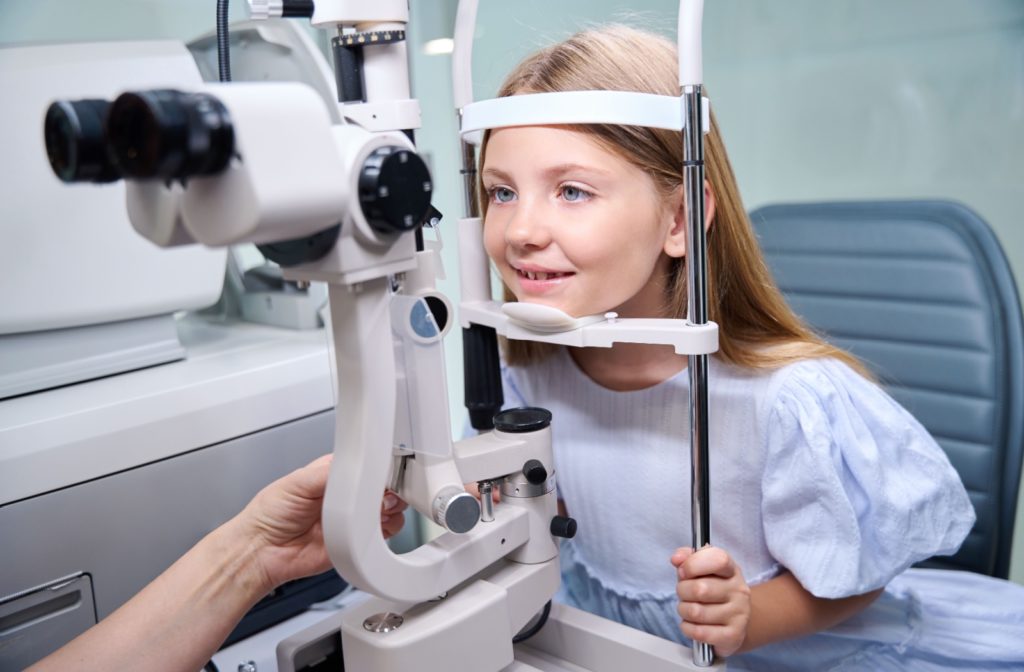Your child’s vision is a crucial part of their everyday life. It’s key to learning, so you should always do what you can to help keep their vision clear.
Regular children’s eye exams are an easy way to do this. They give an eye care professional the chance to monitor their vision and address potential problems long before they become an issue. But how do they do this? What happens during a children’s eye exam?
During a children’s eye exam, your optometrist will examine your child’s eyes. They’ll check your child’s vision, eye movements, coordination, and more. This helps them gain a proper understanding of your child’s vision and eye health and lets them intervene if necessary to help your child maintain clear, comfortable sight.
What Is a Children’s Eye Exam?
If you think back to your last exam, you probably remember the chart on the wall, the machine that flips through different lenses, and your optometrist shining a small light into your eyes. These are all routine tests designed to check your vision and overall eye health. A children’s eye exam is similar, but there are some additional tests and techniques specific to young eyes.
These tests help the optometrist look for conditions like:
- Myopia (nearsightedness)
- Hyperopia (farsightedness)
- Astigmatism (irregularly shaped cornea)
- Amblyopia (lazy eye)
- Strabismus (eye misalignment)
These eye conditions can have significant long-term effects on your child’s vision. Children’s eye exams aren’t just about finding a new prescription or checking visual acuity, they’re about making sure your child’s eyes are properly developing.
Preparing for a Children’s Eye Exam
There will be 3 key stages to your child’s eye exam: before, during, and after. Each step is crucial to checking your child’s vision.
Before the Eye Exam
Before the exam, it helps to make sure your child is anxiety-free. Explain to them that they’ll be visiting somebody who wants to check how well they can see. Reassure them that their eye doctor is friendly, and try to get your child excited for a fun and interesting experience.
Gather any necessary information about your child’s:
- Medical history
- Previous eye issues
- Family history of eye problems
This information will help the optometrist understand your child’s needs better and customize the examination accordingly.
During the Eye Exam
The specific tests and tools used during a children’s eye exam will vary depending on the age of your child. For young children, optometrists often use fun, interactive tests that can evaluate their vision without them even realizing it! These may include pictures, shapes, or even toys that are designed to measure visual acuity.
Older children may undergo more traditional tests like reading letters from an eye chart or using lenses to check for refractive errors. Your optometrist may need to dilate your child’s eyes to properly see inside and check the internal structures.
During all of these tests, your optometrist will be looking for signs of any problems or potential issues with your child’s vision. If they do find anything concerning, they’ll be able to discuss the next steps with you and develop a plan to help your child maintain clear vision.
After the Eye Exam
After the eye exam, the optometrist will discuss the results with you and explain any findings. If your child needs corrective lenses, your optometrist can provide a prescription and guide you on choosing the right pair of glasses that fit your child comfortably and suit their style.
The optometrist will also offer tips on maintaining your child’s eye health and give you personalized advice for their proper development. If any follow-up appointments or additional treatments are needed, these can be scheduled ahead of time so your child’s eye development can be monitored.
How Often Should Children Have Eye Exams?
Regular eye exams are key to maintaining your child’s vision and overall eye health. Typically, you should follow these guidelines:
- The first eye exam should be scheduled between the age of 6-9 months
- Another eye exam should be scheduled between the ages of 2-5 years old
- Annual eye exams should be scheduled until the age of 19
Following this schedule is key. However, if you notice that your child is starting to have troubles with their vision—like constant squinting, complaints about headaches, or needing to sit closer to the TV—you should book an eye exam as soon as you can. Remember: your child’s vision is crucial for their overall well-being, so it’s better to be proactive!
Book Your Child’s Next Eye Exam Today
Taking care of your child’s vision is an excellent way to help them develop. Their vision is an important part of their everyday life, and regular children’s eye exams offer a way to make sure your child is growing well.
At Doctors EyeCare Grande Prairie, we can help. Book an appointment with us today, and let’s work together to give your child the gift of clear vision.




